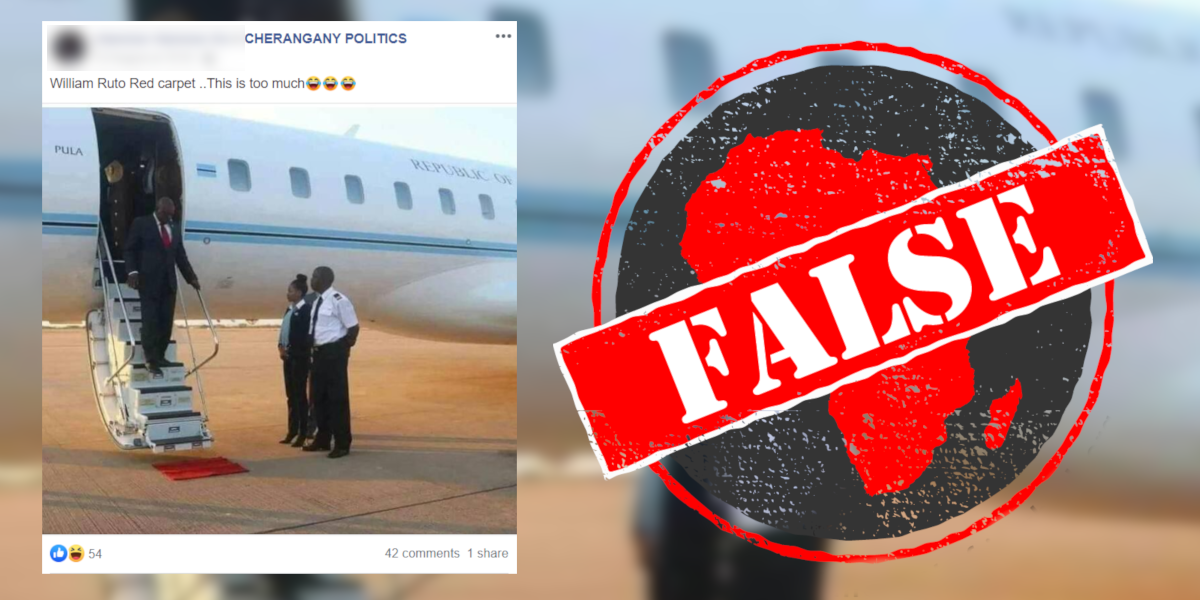A Facebook user shared a photo of what he claimed was Kenya’s deputy president, William Ruto, alighting from an aircraft.
But the red carpet allegedly laid out for the person disembarking was smaller than would have been ordinarily expected for a deputy president, with seemingly only two people receiving him, one in a pilot’s uniform.
There was neither a guard of honour nor other leaders receiving him, as is common in Kenya.
The user captioned the photo: “William Ruto Red carpet… This is too much.” and added a number of grinning emojis. A similar picture posted on Twitter claimed the photo was from Tanzania.

But there are clues that the photo is not of Kenya’s deputy president. Firstly, a closer inspection of the man pictured shows he does not resemble Ruto. This would be more apparent to Kenyans or those familiar with him.
But the aircraft also bears the blue, black and white flag - which are not those found on Kenya’s presidential aircraft. An online check of African flags suggests it is from Botswana, typical of the plane commonly used by the president of the Republic of Botswana, Dr Mokgweetsi Masisi.
The word ‘Pula’ is also visible, with Botswana’s currency being known as the pula.
A reverse image search found similar photos, with users suggesting it could be Botswana’s president.
A leading newspaper in Botswana, Mmegi, also posted the photo on 14 August 2019, saying the photo showed Masisi arriving back in Botswana from Angola.
Some social media users in Botswana also zeroed in on the size of the carpet on account of its seemingly small size.
A day before, Agência Angola Press reported that the Botswana president was in Angola for bilateral talks, and confirmed he was due back in Gaborone, Botswana’s capital, on 14 August 2019. – Dancan Bwire
But the red carpet allegedly laid out for the person disembarking was smaller than would have been ordinarily expected for a deputy president, with seemingly only two people receiving him, one in a pilot’s uniform.
There was neither a guard of honour nor other leaders receiving him, as is common in Kenya.
The user captioned the photo: “William Ruto Red carpet… This is too much.” and added a number of grinning emojis. A similar picture posted on Twitter claimed the photo was from Tanzania.

Clues photo does not show Ruto
But there are clues that the photo is not of Kenya’s deputy president. Firstly, a closer inspection of the man pictured shows he does not resemble Ruto. This would be more apparent to Kenyans or those familiar with him.
But the aircraft also bears the blue, black and white flag - which are not those found on Kenya’s presidential aircraft. An online check of African flags suggests it is from Botswana, typical of the plane commonly used by the president of the Republic of Botswana, Dr Mokgweetsi Masisi.
The word ‘Pula’ is also visible, with Botswana’s currency being known as the pula.
Photo of Botswana president
A reverse image search found similar photos, with users suggesting it could be Botswana’s president.
A leading newspaper in Botswana, Mmegi, also posted the photo on 14 August 2019, saying the photo showed Masisi arriving back in Botswana from Angola.
Some social media users in Botswana also zeroed in on the size of the carpet on account of its seemingly small size.
A day before, Agência Angola Press reported that the Botswana president was in Angola for bilateral talks, and confirmed he was due back in Gaborone, Botswana’s capital, on 14 August 2019. – Dancan Bwire
Republish our content for free
For publishers: what to do if your post is rated false
A fact-checker has rated your Facebook or Instagram post as “false”, “altered”, “partly false” or “missing context”. This could have serious consequences. What do you do?
Click on our guide for the steps you should follow.
Publishers guideAfrica Check teams up with Facebook
Africa Check is a partner in Meta's third-party fact-checking programme to help stop the spread of false information on social media.
The content we rate as “false” will be downgraded on Facebook and Instagram. This means fewer people will see it.
You can also help identify false information on Facebook. This guide explains how.


Add new comment